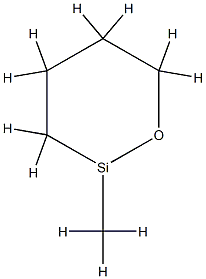Polymethylhydrosiloxane

|
- $21
- Product name: Polymethylhydrosiloxane
- CAS: 9004-73-3
- MF: C5H11OSi*
- MW: 115.22574
- EINECS:
- MDL Number:MFCD00084478
- Synonyms:POLYMETHYLHYDROSILOXANES;POLYMETHYLHYDROSILOXANE, TRIMETHYLSILYL TERMINATED;Methyl hydrogen polysiloxane~PMHS;METHYLPOLYSILOXANEOIL;Poly[oxy(methylsilylene)];methylhydrosiloxane homopolymer;Polydimethylhydrosiloxan;1,3,5,7-Tetramethylcyclotetrasiloxane homopolymer
1 prices
Selected condition:
Brand
- AK Scientific
Package
- 25mL
- ManufacturerAK Scientific
- Product numberO754
- Product descriptionPolymethylhydrosiloxane,tech.Viscosity15-40mPa.s(20°C),tech.
- Packaging25mL
- Price$21
- Updated2021-12-16
- Buy
| Manufacturer | Product number | Product description | Packaging | Price | Updated | Buy |
|---|---|---|---|---|---|---|
| AK Scientific | O754 | Polymethylhydrosiloxane,tech.Viscosity15-40mPa.s(20°C),tech. | 25mL | $21 | 2021-12-16 | Buy |
Properties
Boiling point :>177 °C(lit.)
Density :1.006 g/mL at 25 °C(lit.)
refractive index :n20/D 1.398
Flash point :250 °F
solubility :most ethereal, chlorinated, or hydrocarbon solvents as well as EtOH, i-PrOH, warm DMF, and warm NMP; insoluble in MeOH, DMSO, acetonitrile, and water.
form :Viscous Liquid
color :Clear colorless
Water Solubility :PRACTICALLY INSOLUBLE
Sensitive :Moisture Sensitive
CAS DataBase Reference :9004-73-3(CAS DataBase Reference)
EPA Substance Registry System :Poly[oxy(methylsilylene)] (9004-73-3)
Density :1.006 g/mL at 25 °C(lit.)
refractive index :n
Flash point :250 °F
solubility :most ethereal, chlorinated, or hydrocarbon solvents as well as EtOH, i-PrOH, warm DMF, and warm NMP; insoluble in MeOH, DMSO, acetonitrile, and water.
form :Viscous Liquid
color :Clear colorless
Water Solubility :PRACTICALLY INSOLUBLE
Sensitive :Moisture Sensitive
CAS DataBase Reference :9004-73-3(CAS DataBase Reference)
EPA Substance Registry System :Poly[oxy(methylsilylene)] (9004-73-3)
Safety Information
| Symbol(GHS): | ||||||||
|---|---|---|---|---|---|---|---|---|
| Signal word: | ||||||||
| Hazard statements: |
|
|||||||
| Precautionary statements: |
|
Description
Methylpolysilicones (also called dimethylpolysiloxanes) are high-molecular weight organic compounds of silicon which are similar in chemical structure to inorganic silicates. They are members of a large family in which silicon and oxygen atoms form a siloxy skeleton to which various alkyl and aryl groups are attached in regular, repetitive fashion. The methylpolysilicones may be characterized by the following formula: Si(CH3)3O[Si(CH3)2O] nSi(CH3)3where "n" can be varied from 0 to 10,000 or higher.
The commercial methylpolysilicones are usually linear polymers, although cyclic forms may also be utilized.
Methylpolysilicones can be prepared in viscosity grades ranging from one to several hundred thousand centistokes (cs) depending on the degree of polymerization. Those employed in food uses generally have "n" values of 200-400, with molecular weights usually between 14,000 and 21,000. In this molecular weight range, methylpolysilicones are clear, colorless, viscous liquids, which may contain up to 5% silicon dioxide. With higher degrees of polymerization, resins and rubbers are produced. The methylpolysilicones are insoluble in water and the lower alcohols, but soluble in most aliphatic and aromatic hydrocarbon solvents. The polymers are nonionic, inert compounds strongly resistant to chemical and thermal attack. They are hydrophobic, greasy, and markedly antiadhesive.
silica gel as well as emulsifying agents and preservatives. Foodgrade methylpolysilicones must meet the following specifications:
Refractive index: 1.400 to 1.404.
Specific gravity: 0.964 to 0.973.
Viscosity: 300 to 600 cs.
Loss on heating: Not more than 18%.
Limit of impurities: Arsenic, not more than 3 parts per million (ppm); heavy metals, not more than 10 ppm (expressed as lead).
The antifoaming and hydrophobic properties of dimethylpolysilicones are also utilized medically in patients suffering from excessive gas production or retention such as flatulence, gastric bloating, or postoperative gaseous distention. They have also been used to reduce gas shadows in radiography of the bowel and to improve visualization in gastroscopy. The usual therapeutic adult dose is 150-400 mg daily. Silicones are also employed to prevent dermal irritation in bedridden patients. Medical grade preparations (simethicone) must contain 93-99% dimethylpolysilicone, not more than 4.5% silicon dioxide, and have a viscosity not less than 300 cs.
Because of their chemical and thermal resistance together with their antiadhesive and hydrophobic properties, methylpolysilicones have found various uses in the food industry. They are used to coat containers and molds for bakery products, candies, and confections; to impregnate packaging and wrapping paper which contact foods; and to reduce foaming in various fermentation and canning processes. Methylpolysilicones at low concentrations (0.03-0.05 ppm) reduce thermal and oxidative deterioration of frying fat by forming a protective film at the oil-air interface. At higher levels (1-10 ppm), silicones added to shortening and other frying fats may eliminate smoking difficulties by raising the smoke point 20-30°F. Silicones have also been incorporated into cellulosic sausage casings to facilitate the casing removal from the enclosed meat mass.
Related product price
- Ethylene dimethacrylate
$6-4124.97 - POLY(METHYL METHACRYLATE)
$14-4580 - Methyl propiolate
$6-2624.35
Suppliers and manufacturers
Henan Tianfu Chemical Co.,Ltd.
Hangzhou FandaChem Co.,Ltd.
Tianjin Zhongxin Chemtech Co., Ltd.
Hubei Jusheng Technology Co.,Ltd.
Chongqing Chemdad Co., Ltd
CONIER CHEM AND PHARMA LIMITED





